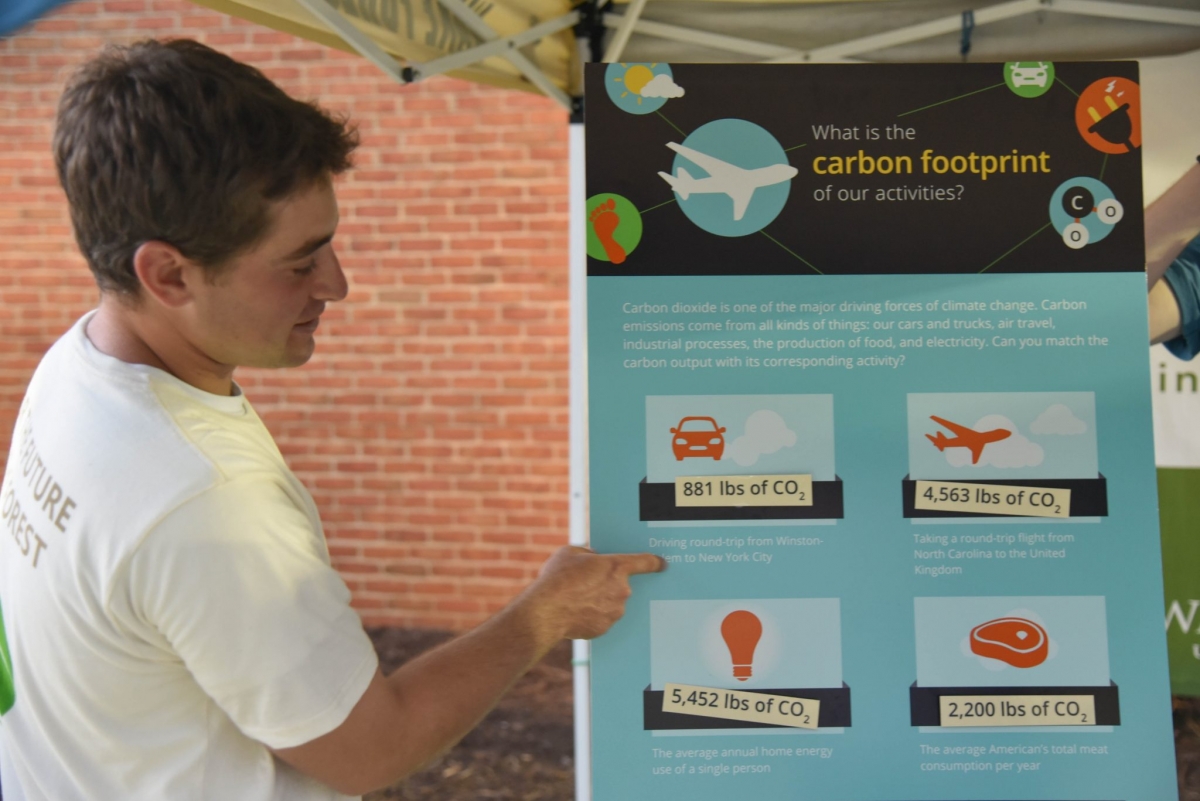WFU measures carbon footprint, first step in Climate Action Planning

The University’s publicly available carbon inventory measures the greenhouse gas emissions of our campus — and the trajectory is headed in the right direction.
Contributor: Adam Tomasi ‘19, Office of Sustainability Content Assistant
Did you know that South Hall uses solar-thermal energy for hot water and Reynolds Gym uses it to reheat the pool water? Or that over 90% of lights in 11 buildings have been converted to LEDs including Benson, Reynolds Gym, the Hearn Plaza residence halls, and Wait Chapel? Or that the university efficiently generates and distributes all the chilled water that cools and conditions the air inside our campus buildings?
Since 2007, Wake Forest has invested in energy efficiency measures that, paired with a cleaner energy mix, have resulted in a reduction of our greenhouse gas (GHG) emissions per building square foot by over 30 percent.
You can’t manage what you can’t measure.
The university’s carbon inventory is a spreadsheet, with formulas that multiply the energy we use on campus by greenhouse gas coefficients. Those results are all expressed in carbon dioxide (CO2) equivalents, ergo the moniker carbon inventory. It includes energy used across campus — from the main campus to Graylyn and Reynolda House, to the athletic buildings and the buildings in the university’s real estate portfolio. Jimmy Nifong, the manager of utilities operations at Wake Forest, collects all of the records of the energy used and converts that into metric tons of CO2 equivalents.
Wake Forest maintains this measurement of the campus’s greenhouse gas emissions beginning with fiscal year 2007. The accounting contributed to the university’s gold rating from the Association for the Advancement of Sustainability in Higher Education (AASHE) in fall 2018. The carbon inventory is the first step in creating a comprehensive action plan to reduce the greenhouse gas impacts of campus life and operations.
The accounting spreadsheet not only looks at carbon dioxide equivalents from electricity and natural gas, but also from hydrofluorocarbons (HFCs) in our refrigerants, and nitrous oxide in our fertilizers. Both HFCs and nitrous oxide are greenhouse gases that, like carbon dioxide, rapidly warm the planet. These make up such a small percentage (less than 2% each), however, that they are considered de minimis.
The majority of emissions result from two primary sources: the fuel sources that Wake Forest burns and the electricity that Wake Forest purchases. The former are called Scope 1 emissions; the latter Scope 2. Wake Forest’s inventory does not currently include Scope 3 emissions, such as those generated as a result of employee commutes or production of goods in the supply chain, like educational supplies.
The lowest-carbon energy is the energy we don’t use.
Nifong has watched Wake Forest’s energy efficiency increase since fiscal year 2007, which is the baseline for the carbon inventory. “Even with square foot growth on the main Reynolda campus, the university is purchasing less electricity to power those buildings,” Nifong said.
The university’s Scope 2 emissions are dependant on two factors: Duke Energy’s electrical generation mix and how much electricity we use on campus. Duke Energy, which holds a legal monopoly on electrical generation and distribution in the region, generates electricity from about a third coal, a third natural gas, and a third nuclear sources. In the realm of fossil fuels, natural gas emits less carbon dioxide than coal. Electricity generated in nuclear reactors is carbon free.
What matters more than Duke Energy’s mix, Nifong emphasizes, is the energy efficiency of our buildings. “Regardless of where we get electricity from, if we can reduce energy use in our buildings, we’re moving the needle in the right direction,” Nifong said.
All actions are not equal.
The carbon inventory can help us contextualize our individual and campus-wide initiatives to reduce our climate impact. From an emissions perspective, our electricity consumption, and the way we get around, matters far more than whether we recycle or use plastic straws.
“When it comes to greenhouse gas emissions, not all actions are equal,” said Dedee DeLongpre Johnston, chief sustainability officer at Wake Forest. “When suitemates agree to turn off all their lights and devices when they leave, or carpool to the store, that makes a difference.”
Nifong agrees that human behavior change is an important piece in the energy efficiency and emissions puzzle: “The most efficient light is one that’s off.”
